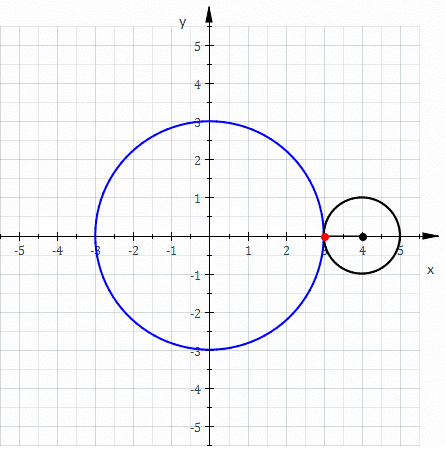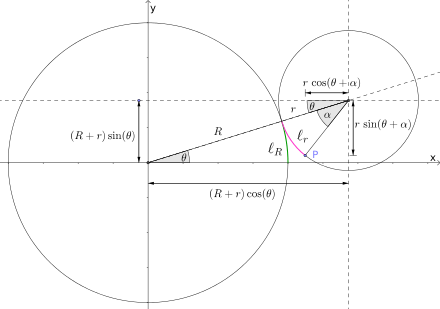Epicycloid

In geometry, an epicycloid is a plane curve produced by tracing the path of a chosen point on the circumference of a circle — called an epicycle — which rolls without slipping around a fixed circle. It is a particular kind of roulette.
Equations
If the smaller circle has radius r, and the larger circle has radius R = kr, then the parametric equations for the curve can be given by either:
or:
If k is an integer, then the curve is closed, and has k cusps (i.e., sharp corners, where the curve is not differentiable).
If k is a rational number, say k=p/q expressed in simplest terms, then the curve has p cusps.
If k is an irrational number, then the curve never closes, and forms a dense subset of the space between the larger circle and a circle of radius R + 2r.
- Epicycloid examples
-

k = 1
-

k = 2
-

k = 3
-

k = 4
-

k = 2.1 = 21/10
-

k = 3.8 = 19/5
-

k = 5.5 = 11/2
-

k = 7.2 = 36/5
The epicycloid is a special kind of epitrochoid.
An epicycle with one cusp is a cardioid, two cusps is a nephroid.
An epicycloid and its evolute are similar.[1]
Proof

We assume that the position of is what we want to solve, is the radian from the tangential point to the moving point , and is the radian from the starting point to the tangential point.
Since there is no sliding between the two cycles, then we have that
By the definition of radian (which is the rate arc over radius), then we have that
From these two conditions, we get the identity
By calculating, we get the relation between and , which is
From the figure, we see the position of the point clearly.
See also
- List of periodic functions
- Cycloid
- Cyclogon
- Hypocycloid
- Epitrochoid
- Hypotrochoid
- Spirograph
- Deferent and epicycle
- Epicyclic gearing
- Multibrot set
References
- J. Dennis Lawrence (1972). A catalog of special plane curves. Dover Publications. pp. 161,168–170,175. ISBN 0-486-60288-5.
External links
- "Epicycloid" by Michael Ford, The Wolfram Demonstrations Project, 2007
- O'Connor, John J.; Robertson, Edmund F., "Epicycloid", MacTutor History of Mathematics archive, University of St Andrews.
- Animation of Epicycloids, Pericycloids and Hypocycloids
- Spirograph -- GeoFun
- Historical note on the application of the epicycloid to the form of Gear Teeth